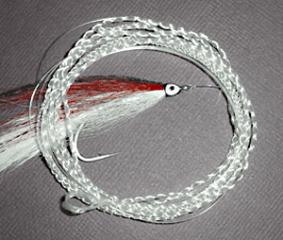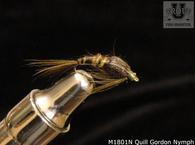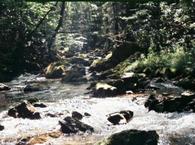
In this class the student will learn about furled leaders as an alternative to the monofiliment leaders that are so common in prcatice today. The student will learn the pros and the cons of the furled leader and how they are constructed.
FIRST, a little furled leader primer. The furled leader has been around since the 1700s and the earliest versions were woven by hand from silk or horse hair. In fact until the invention of monofilament, almost all fly fishing leaders were braided multi-strand leaders made from natural fibers. But in the middle of the 19th century, cheaper materials and faster production all but eliminated their availability and use. Now, because of its many advantages, the furled leader is enjoying a rebirth, especially among dry fly fishers.
I must admit to not knowing much about furled leaders until a few of them landed on my desk recently. What impressed me, originally, was finding out that they were patiently made, by hand, one at a time. Why would anyone go through the trouble of doing so with so many high-quality mono leaders available at a lower price? Some quick math provides an answer: these leaders can last an entire season or even more.
BlueSky trout leaders are woven from over 90 feet of premium quality nylon to a length of five feet, nine inches (the Stillwater leader is 8' 4" in length and is woven from over 120 feet of nylon). The leaders are woven with a nylon that has a neutral buoyancy. BlueSky uses this nylon so that anglers who fish wet will be able to get the leader and fly down to the chosen depth. On the other hand, applying a light coating of silicone floatant over the leader's entire length makes it well-suited for dry flies too.
The actual construction looks and is very simple. The magic lies in the formulas used to balance each leader for each specific fishing situation. BlueSky offers a complete range covering everything from ultra-light fishing applications to furled leaders with titanium bite guards for toothier salt water denizens. They also produce spey leaders.
Homemade mono leaders rely on three to four separate knots, each one acting as a constant invitation to slime and more solid debris. Furled leaders taper smoothly from end to end, with no knots. No question that fishing a clean leader reduces drag, makes the leader less visible, and helps in executing the cast as well.

Handling a furled leader for the first time is a little strange. They're completely and uniformly limp, from the tippet all the way to the end of the butt section. This overall limpness allows for a smoother and more complete energy transfer during a cast. To be fair, many mono leaders allow for smooth power transfer, but furled leaders unfurl more evenly, increasing an angler's ability to deliver flies more delicately.
One would immediately suspect that a larger diameter be a hindrance during a cast (after all, fly line manufacturers wrestle with this variable all the time), but many furled leader adherents believe that the smoother power transfer results in tighter loops — thereby balancing out the negative effects of a larger diameter. Still, furled leaders are more affected by wind — they may not be the best choice if you find yourself punching casts into or across a stiff breeze. (But then, in those situations delicacy of presentation becomes less important anyway.)
General Observations: If you're aiming for the ultimate in delicate presentations, furled leaders are a great choice. They lay out feather-light on account of their flexibility, perfect taper, and larger diameter. Furled leaders can also improve a roll cast, taking advantage of the increased surface tension that the leader provides during the initial part of the cast. Although they can be used with any type of fly rod, I noticed that they are an excellent buffer for faster rods that might lack some of the finesse provided by slower-action rods — 'leader slap' is easily kept to a minimum.
The price for a furled leader may seem a little steep at first, but given they are handmade and offer a unique, ultra-fine fishing experience, they're definitely worth a try. And although they're but one link in the entire chain of fly fishing tools, they have the potential to change the way you fish, especially if you lean towards light to ultra-light fishing.
Pros: Built-in loops for fly line connection, tighter casting loops, very delicate turnover and delivery, and durability/value: one leader can potentially last an entire fishing season.
Cons: More suitable for dry fly angling (although heavier versions exist: salt water, spey). Use of furled leader in below-freezing temperatures not recommended due to probability of ice build-up.
This class is based on an adaptation from an article by Robert Morselli that first appeared in MidCurrent.
Robert Morselli is the research director for the television show "How It's Made." He contributes regularly to Canadian Wildlife Federation magazine and elemente design magazine. Please go to Google and read more of Robert's articles.
Learn how to make furled leaders by going to "Making Furled leaders" by Claude Freaner.
Check out the furled leaders available at Cabela's.





